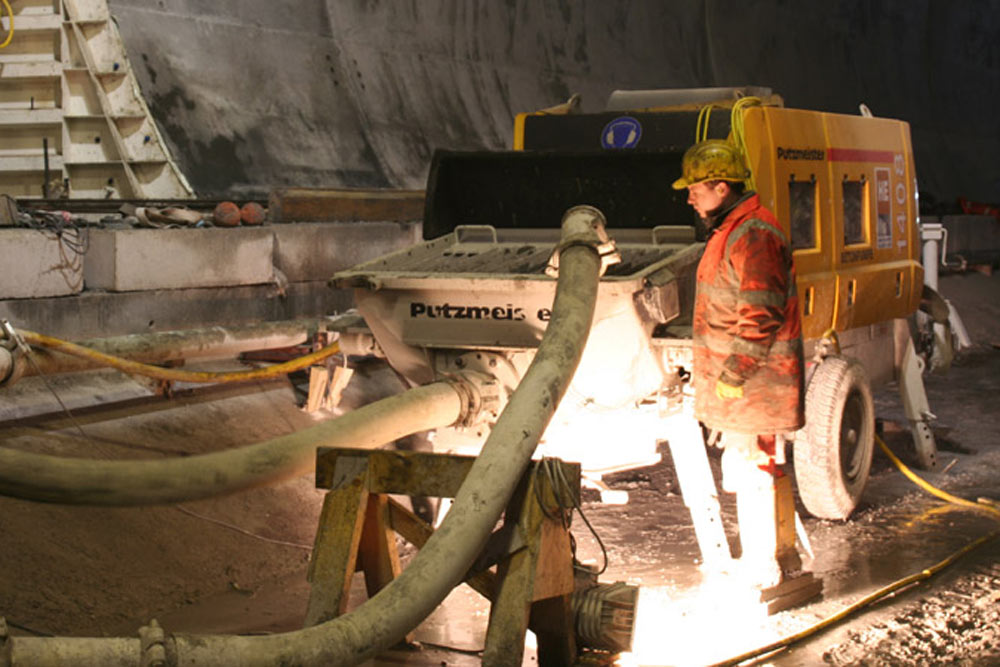Lainzer Tunnel, Vienna, Austria
Feb 19, 20
Lainzer Tunnel, Vienna, Austria
Long Tunnel and Long Distance Concrete Pumping, Nothing Fell Short
The Lainzer Tunnel, a 8 miles (12,8 km) railway tunnel in Vienna was slated to connect the Westbahn (western railway) with the Südbahn (southern railway) and the Donauländebahn railway from December 2012. The idea was to increase the capacity of the east-west transit system.
The Challenge
- To execute the inner lining in built-up areas, the concrete for separating the underground transport traffic from the above-ground transport traffic was pumped through a permanently installed delivery line. This line measured between 990' (300 m) and 4595' (1400 m) in length, from the concrete mixing plant at the construction site directly to the placement site.
- The concrete mixture needed to meet specific structural and pumping requirements and was subject to continuous monitoring.

The Solution
The LT 31 consortium (HOCHTIEF Construction AG, Alpine Bau GmbH and Beton-und Monierbau GmbH), under the leadership of HOCHTIEF Construction AG, was commissioned by the ÖBB-Infrastruktur Bau AG to construct a main section of the Lainzer Tunnel.
The interior construction of the tunnel was performed using a watertight concrete inner shell (d>= 20' (50 cm)), with PP fibres added to the concrete in order to improve its resistance to fire. In addition, the inner shell was designed with an 3.2" (8 cm) enlarged concrete covering of the reinforcement (reinforcement proportion of the tunnel lining is approx. 190 lb/yd3 (85 kg/m3) of concrete).
The formwork carriages for each segment of the tunnel were 32'10" (10 m) in length, resulting in an installation quantity of approx. 197yd3 (150 m3) of concrete for the tunnel lining of each concreting section and of 118yd3 (90m3) for the base.
The interior work had already commenced in parallel to the headwork, and the concrete was fed via two vertical starting shafts. It was decided at an early stage to supply the concrete for the formwork carriages using a stationary concreting facility – comprising a stationary concrete pump and a specially designed delivery line. As a result of the positive experience gained from the beginning, this form of concreting logistics was maintained even after the headwork was completed.
A stationary concrete pump BSA 2109 H E (later a BSA 2107 SHP E) pumped concrete via a delivery line that was permanently installed in the tunnel from above ground to the arch and base carriages, which were a maximum of approx. 4595' (1400 m) away.
The DN 150 delivery line was cleaned by using water to force the concrete residue out in a “forwards“ direction. Depending on the length of the line, this work was carried out by a BSA 2109 H D or a BSA 1409 D. “Forwards“ water cleaning is usually selected for relatively long concrete delivery lines in order to prevent large quantities of concrete residue from forming.
The BSA BSA 2107 SHP E pumped approx. 37yd3 (28m3) of concrete per hour over the distance mentioned above to the arch or base formwork carriage.
A tunnel section of 20 tunnel segments, each 32'10" (10 m) long, was produced from self-compacting concrete (SCC). For this purpose, the Pöyry Infra GmbH (MVA Strass) laboratory specially formulated a concrete mixture.
Concrete Takeaways
- Long distance concrete pumping successfully carried out.
- Good service, planning and ingenuity ensured the structural and pumping requirements were met for this prestigious project.
Putzmeister Equipment
BSA 2109 H D4
BSA 2109 H E
BSA 1409 D
Project Partners
The LT 31 consortium (HOCHTIEF Construction AG, Alpine Bau GmbH and Beton-und Monierbau GmbH), under the leadership of HOCHTIEF Construction AG, was commissioned by the ÖBB-Infrastruktur Bau AG to construct a main section of the Lainzer Tunnel.